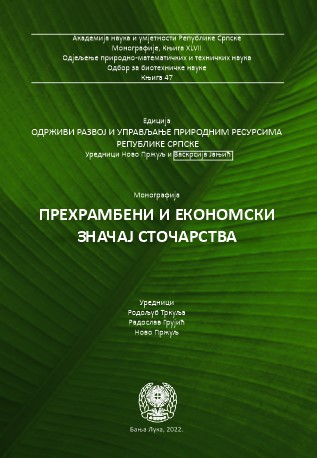Quality and categories of raw milk
DOI:
https://doi.org/10.7251/EORU2204231SKeywords:
Milk, production, consumtion, dairy productsAbstract
Milk is one of the oldest foods in the human diet, and as such, it has been used since ancient times. It is one of the most important and most meaningful food, because it serves to reproduce the species. It didn't take to much time to the man to see this and use the fresh milk of mammals for his diet. The milk contains many nutrients, among them proteins, calcium, vitamins B2, and B12, phosphorus and potassium stand out. Nowadays, approximately 82% of the milk production in the world is produced by cows and the other 18% of buffalos, goats, sheeps and camels. Other rare milk animals are yaks, horses, reindeer and donkeys. The presence and importance of each species varies significantly between regions and countries. The key elements to be determined by the dairy species held are food, water and climate. Other factors that may affect the presence of dairy species are market demand, nutritional habits and socio-economic characteristics of individual domains. Milk is processed in order to obtain dairy products which are more durable, have higher nutritional value and collate the milk offer, and they include cheese, yogurt, butter, condensed milk, milk powder and ice cream. In the 10-year period (1990‒ 2000), the total world production of all types of milk had increased for 5,67% and it was 568.480.000 tonnes in 2000. Up to 2018, the total world milk production increased for 48% compared to 2000 by reaching 841.840.000 tonnes. In 2019, the world's milk production remained on a stable path of growth of more than 2%. Production in the region with a lack of milk, in Asia and other dairy markets, is highlighted by strong local demand growth, as well as on average affordable milk prices. The second growth factor is the production of buffalo milk, which has an annual growth rate of 4,0% in the period 2010-2019, which is higher than twice the growth rate of cow's milk (1,9%) This consistently higher increase in buffalo milk production caused increasing share of buffalo milk in world milk production from 8% in 1990 and 13% from 2010 to a level of 15% in 2019. The first ten countries in the world with the most consumed and processed milk per capita are in Europe, led by Finland, Sweden, and Holland. The region of former Yugoslavia is led by Montenegro, which ranks in the high level 6 in the world with 305 pounds [305 кг] of milk per capita in the year, which shows that an exceptionally small cattle fund and total milk production has no impact on its consumption. The production of fresh raw milk in Republika Srpska and BiH is one of the most important agricultural branches with the potential to be a stable backbone of agricultural and rural development. The importance of the dairy sector in BiH is reflected in the fact that dairy farming is among sectors with a major value of primary production of 300 million SGUs per year, a sector which is extremely important for the food security of the country, one of the most demanding in the standards to be met in the EU accession and the sector in which BiH has significant potential for further development. The number of dairy cows in the last decade has decreased in Republika Srpska by one third (32,4%). Thus, the significant reduction of dairy cows number led to a noticed drop in the amount of milk produced in Republika Srpska. For the period 2009‒2018, there was a reduction in the total quantity of milk produced by 25% or by 106 million litres per year. During the same period average milk production per dairy cow showed significant increase. In addition, a notable increase of the high milk quality share was recorded, i.e. milk that met all the conditions laid down by the rules. In 2016, such milk was 67.80% while 75.70% in 2000 (more than 95% in the developed countries).
